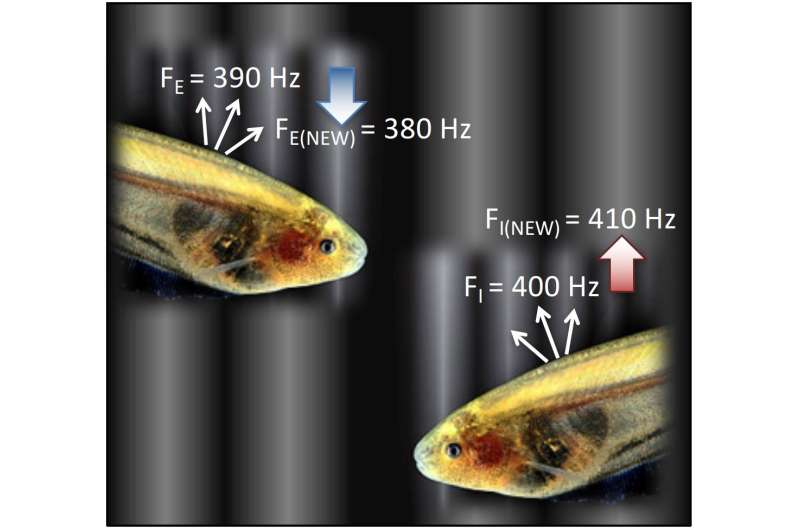How to use limited bandwidth more efficiently? Think like a cave-dwelling fish

For the first time, researchers have demonstrated a light-based device that mimics a fish's incredible jamming avoidance response (JAR) by moving the frequency of an emitted signal away from other signals that could potentially cause interference. The new system could eventually help overcome the spectral bandwidth crunch caused by ever increasing numbers of wireless devices and transmitted data competing for space on a limited amount of available bandwidth.
Eigenmannia are cave-dwelling fish that live in complete darkness. To survive without the presence of light, the fish emit an electric field to communicate with other fish and to sense the surrounding environment. When two fish emit signals at similar frequencies they can interfere with each other, or jam, creating a scrambled signal. Thanks to a unique neural algorithm, these fish can adjust their electric communication signals so that they don't interfere with those coming from other nearby fish.
"We think that humans could use the same jamming avoidance response neural algorithm as the Eigenmannia, but at a much faster speed and frequency," said research team leader Mable P. Fok from the University of Georgia. "This could allow a smarter and more dynamic way to use our wireless communication systems without the need for the complicated coordination processes that currently prevent jamming by reserving whole sections of bandwidth for specific phone carriers or users such as the military."
In The Optical Society (OSA) journal Optics Express, the researchers demonstrated a light-based, or photonic, JAR that can be used to avoid jamming. They showed that the system performs much like the Eigenmannia's JAR in that it detects whether another signal could present a jamming problem and then intelligently shifts its emitting signal higher or lower in frequency so that it moves away from the jamming signal without crossing its frequency, which would amplify the jamming.
Because the jamming avoidance system is light-based, only slight adjustments are needed to use it with a wide range of frequencies: from the megahertz frequencies used for radio and GPS communication to the gigahertz signals used by cell phones and radars. Using a light-based device also allows faster automatic response to a potential jamming signal than an electronic system could accomplish.

Cutting down the interference
The new technology could help with signal interference in several areas. For example, it could be used to avoid unintentional jamming when radars aboard planes or military vehicles are operating in the same area. It could also be used in environments such as hospitals where wireless devices can interfere with wireless transmissions coming from medical instruments.
"Eventually, this approach could be used to achieve effective use of the wireless spectrum by allowing wireless devices to automatically move to a frequency that doesn't interfere with other signals nearby," said Fok. "This could bring down the cost of using the wireless spectrum because service providers would not have to pay to reserve large amounts of bandwidth. This, in turn, could make it more affordable to bring mobile technology to developing countries, where it could be used to support important services such as telemedicine or distance learning."
Mimicking neurons
The new photonic JAR system uses an off-the-shelf optical component known as a semiconductor optical amplifier (SOA) to mimic the Eigenmannia's JAR. The SOA identifies the properties of its own emitted signal and uses that as a reference to detect a potential jamming and to determine if that signal is higher or lower in frequency. It then moves the emitted signal away from the potential jamming signal.
"To create the photonic system, we had to understand how neurons in Eigenmannia carry out the JAR and then translate that from an engineering viewpoint into a photonic design," said Fok. "Because the SOA actually acts very much like a neuron it could be used to do all the necessary tasks."
The researchers tested their photonic JAR using various types of jamming signals in the microwave region of the electromagnetic spectrum, which is used for local area wireless networks such as Bluetooth. "We could see the photonic JAR system move the signal frequency when a jamming signal was approaching and stop moving if the jamming frequency was moving away," said Fok. "It happened automatically, almost as if it were alive."
The researchers are now working to improve the system so that it can respond to more than one jamming signal nearby. They also want to make the system portable and more user friendly for non-technical users.
More information: Ruizhe Lin et al, Biomimetic photonics: jamming avoidance system in Eigenmannia, Optics Express (2018). DOI: 10.1364/OE.26.013349
Journal information: Optics Express
Provided by Optical Society of America




















